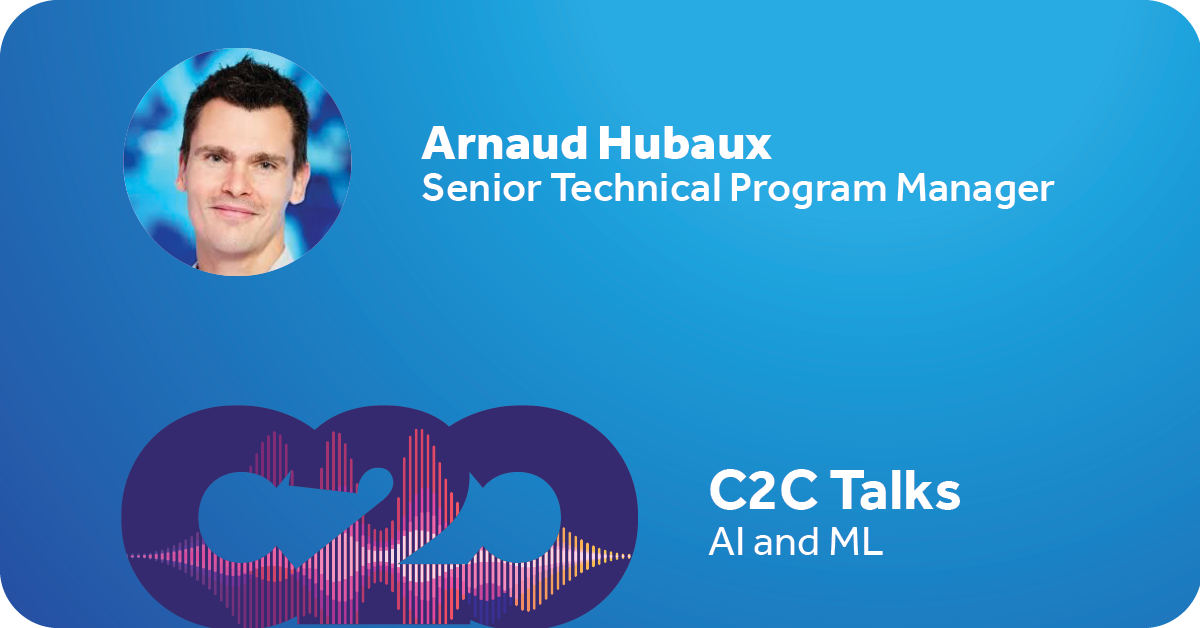
Going from concept and ideas to solutions that you can industrialize is the most significant challenge with AI on Google Cloud. It's not the prototypes and test ideas; it's getting it through the door, ensuring it's reliable, and it doesn't put lives or livelihoods at risk or damage any equipment.
Tackling the common-but-considerable challenge is Arnaud Hubaux, senior technical program manager at ASML, an equipment manufacturer and service provider headquartered in the Netherlands. An AI trailblazer that is self-proclaimed to be "customer-obsessed" blends physics with ML to create decision-making models that predict anomalies during microchip production.
Being that he is only satisfied when trained models help customers reduce their spending and increase their yield, Hubaux sat down with the community for a C2C Talks* on AI and ML and shared his journey while answering questions live.
What was the primary challenge?
There are a few. ASML is global with 25,000 employees working in 118 countries, so there is a lot of management involved. But if that weren't complex enough, its products also require working at the nanometer level, being precise but industrial and produced at scale with efficiency.
For a little more context into the ASML world, the new A14 microchip, used in the new iPhone 12, is made by TSMC on ASML machines. In terms of that production, ASML owns 85% of the market share and with customers all over the world.
So, ASML makes the machines that create the chips and uses AI to optimize the behavior of those machines. Each chip is composed of layers and pipes - think of Lego building blocks. Different machines create each layer, so they need to ensure accurate communication and synchronization for precise layering, and it needs to occur at scale. If any layer is amiss, the entire structure can collapse, resulting in a nonfunctioning chip. Additionally, Hubaux explained that ASML products are deployed in environments where there is no internet connectivity. Hence, there is no monitoring access on the system, meaning the AI will need to deploy and learn independently and adapt to any variation in the context.
In a nutshell, they need to get their physics right, have their predictive economics precise, and ensure the ML model can learn efficiently and effectively.
Hear the full explanation of the challenges below.
How did you use Google Cloud Products as a solution?
Hubaux explains how his team uses a collection of Docker containers to run atop Kubernetes, allowing for easy deployment on a customer premise with no internet connection. But to get there, they start from their on-premise data store, which will contain data samples from their customer sites, for example. The data goes into Google Cloud, where they've implemented a storage buffer, and it triggers a notification and a data pipeline, a Kubernetes cluster. The necessary data is extracted from the data packages and loaded into BigQuery, where domain experts can start working in their AI notebooks.
Hear how the stack comes together in more detail below:
And how's it going?
Trusting your business on this technology and wanting to share your story is a powerful enough statement for how well it's going. Since so much of ASML's product development depends entirely on this flow, Hubaux explained why they went with Google Cloud and chose this technology.
"The reason why we went for a Kubernetes cluster for the data pipeline and the data flow or any Google-specific technology is because we want to have a pipeline that is easy to transfer from one environment to the next, being on-prem or in Google Cloud, or even running at another cloud vendor because that data pipeline has a lot of domain knowledge in it," he said.
Community Questions
What did you face in building and training this? And how did you overcome them?
"The biggest roadblock for us is that we don't know at all what data or what quantity or quality of data we'll see when we are at customer sites. It forces us upfront to think about all kinds of weird combinations of kinds of effects that can occur and then test for them and make sure we are robust," Hubaux said.
Hear his full answer below:
How do your yields compare to other traditional semiconductor processes?
"That's a difficult issue because how semiconductor manufacturers apply those techniques is extremely IP sensitive, and there is hardly any information out there," Hubaux explained. "But what you see is that there is a general mistrust towards ML. If you cannot explain exactly how it works, for me, it's still black box that people don't trust. This is why explainability is so important - is it's not about which techniques we use."
Hear his full answer below:
Extra Credit
- The Google AI-focused blog released its research recap for 2020 and looks ahead to 2021. It's rich with detail, insights, and ideas.
- Need a crash course on ML? This training is geared toward developers and for those looking to get started.
- Looking to accelerate transformation with analytics, AI, and ML? C2C spoke with Google's Andrew Moore in September, and it's a discussion worth revisiting.
- Curious about ASML or to learn more about Arnaud Hubaux and how he works with Google Cloud products? You can hear him on the GCP Podcast!
We want to hear from you!
To learn with your peers in our C2C Connect groups, you can sign up here. We have a room for each of our primary topic areas. Explore to find what's right for you.
*C2C Talks are an opportunity for C2C members to engage through shared experiences and lessons learned. Often there is a short presentation followed by an open discussion to determine best practices and key takeaways.
If you'd like to participate in a C2C event or have a topic idea, please join our community and contact Sabina Bhasin, content manager, with your ideas.